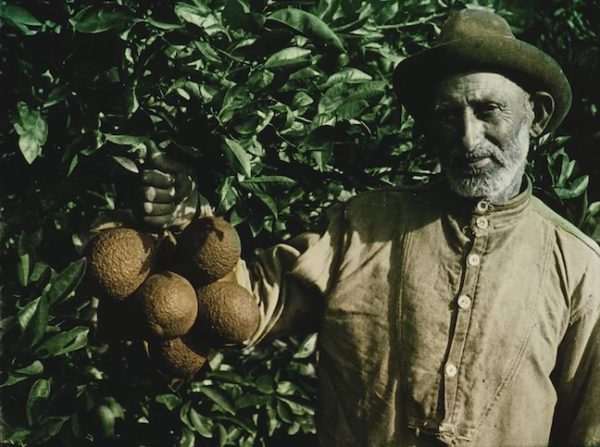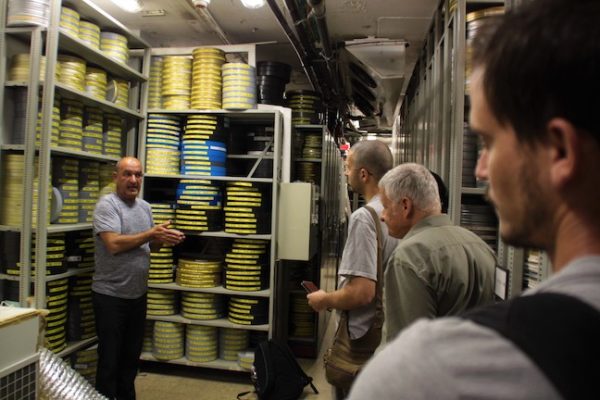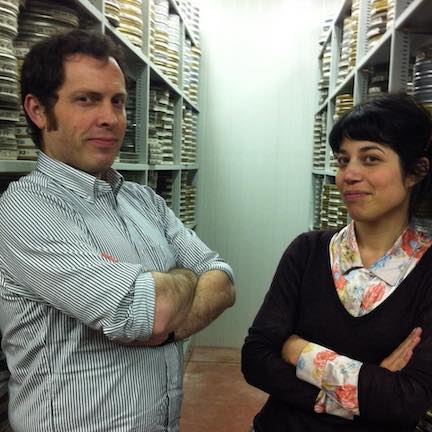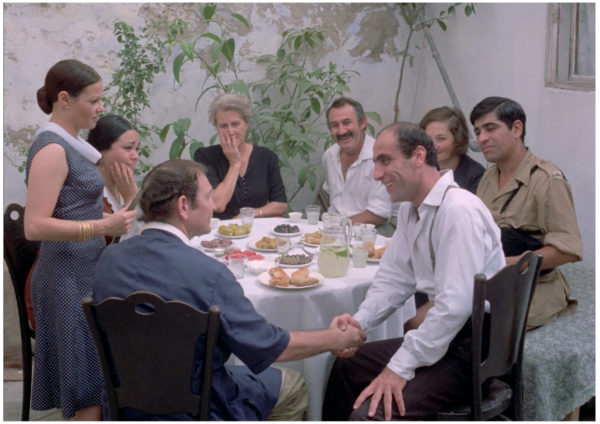Israel Film Archive Wants All Israeli Film

A frame from a “showreel” of the Archive’s holdings of “pre-state” footage captured before the establishment of the state of Israel.
The Israel Film Archive wants your home movies, whether you’re within Israel or anywhere in the Jewish diaspora.
But collecting home movies is just part of a very large project being conducted by Russo Meir and his colleagues at the Archive.
As the Archive is the official institute responsible for the collection and preservation of Israeli films, they want to be able to provide original reels or digital copies of every film ever made in the country.
That’s an ambitious undertaking even for the largest film archive in the Middle East, one that holds over 30,000 screening prints, 20,000 video cassettes, and thousands of negatives of Israeli films.
To add to the archivists’ challenge, they want to digitize and have available online the whole of the Archive’s collection.
At least, that’s the dream, says Russo, the manager of the Archive, which is part of the Jerusalem Cinematheque, whose director is Noa Regev.
Russo’s colleague, Hila Abraham, director of the Archive’s Digital Preservation and Access Project, says: “We always knew we had a treasure but we decided we had to make it accessible to the world by contemporary means.
“We researched what was happening in the world in terms of best practices, which took us a while. We’re glad we took the time to do that in-depth research. We got in touch with every archive we could. It also involved AV Preserve from New York; they were here to help us.”

Russo Meir, the Archive’s director, leads a tour of the facility.
The digital preservation and access work began about four years ago, mainly with 16mm and 35mm films, as it would at any national film archive. Documentary films, fiction films, student films, newsreels, commercials… All have been in the mix, as have prints of films from other countries that had screened in Israel. (The Archive’s founder Lia van Leer, before she died in 2015, tirelessly pressed studios abroad to allow her to collect their films rather than return them.)
The first film known to have been shot in what has since 1948 been the State of Israel is at the Archive: it was made in 1896 by a Lumière brothers cameraman and is a seven-minute film depicting Jerusalem, Jaffa, and Bethlehem.
Also in the archive is a handpainted film from the 1920s recovered from the former Yugoslav film archives. “We really love it,” says Abraham. “It’s the only handpainted film we have in the archives. It’s beautiful. We don’t know a lot about who shot it. But whoever did shoot it, you can see that it was from a different point of view: he shot Bedouins, Jews, Palestinians, Christians… It was a very compassionate filmmaker, whoever made it.”
Other prized items in the collection include footage depicting a dog show in Tel Aviv in 1935, memorable events of the Zionist movement such as settlements being built at the time of the formation of the State of Israel, the effects of a tuberculosis outbreak in 1949, the record 1950 snowfall in Jerusalem, and a visit with Albert Einstein.
Among more recent Israeli films, the Archive holds, for example, Avi Nesher’s Rage and Glory (1984) about pre-state underground-movement fighters resisting British rule in the early 1940s, a film that the Film Society of the Lincoln Center acclaimed as one of Israel’s most important ever. Then there’s Rafi Bukai’s Avanti Popolo (1986), about two Egyptian soldiers stuck in Israeli during the Six Day War, and Assi Dayan’s Life According to Agfa (1992), a portrait of a Tel Aviv bar’s patrons.
For its digitization project, the Archive is drawing on collecting that began with its establishment in the early 1960s. Even then its goal was to collect at least one copy and one negative of every full-length feature film produced in Israel and pre-State of Israel, starting with the first Hebrew dramatic film, Oded the Wanderer (1932), an allegory of the Jewish wanderer.
One challenge, when it come to collecting fiction films, is that since 1994 Israel has had no processing laboratory for them, so that negatives and sound elements have been sent out of Israel for processing. Part of the Archive’s project is to bring back at least digital copies of them.
Cooperating With Other Archives

Josh Ranger from AVPreserve of New York, which guided the Israel Film Archive’s digitization program, and Hila Abraham, the Israeli institute’s Digital Archive Program Director.
Under the Archive’s model, it asks rightsholders to lend films without relinquishing copyright; the Archive can then digitize them and place them online so that members of the public may view them for a basic fee. Said Russo: “If there are any titles that we are missing, and they are held in other archives, we are cooperating with them. We are digitizing their material for them. By the same principle, they are giving us a digital copy, and we can show it on our website.”
That sort of cooperation also benefits the rightsholders, because the Archive’s digitization lab is the only fully professional one in the country, Abraham noted. “And if you think about it, we’re in the Middle East, and unfortunately our relations with our immediate surroundings are not that good. If rightsholders want to digitize their films, it involves a lot of money because they have to send them to Europe, or to the U.S., or elsewhere.”
For the Archive, she said, providing access is crucial. “We understood that he have to bring it to the people, to their personal computers,” Abraham said. Her goal is, by the end of 2020, to make as much material as possible available online with commentary and metadata in Hebrew and English.
One pillar of that project is thorough historical annotation, and searchability, she said: “The archive is the gateway to our history. So we plan to allow people to search according to places, people, subjects… It’s going to be very elaborate.” When, for example, users search for “David Ben Gurion in Tel Aviv in the 1950s,” those parameters will take the users directly to relevant segments of films — “so you really jump into the moment, through film,” as Abraham put it. Historical newsreel has been one major focus of the Archive’s project.
To meet the costs of the project of bringing all Israeli films to Israel, in some form of other, the Archive has been able to attract funding from several sources, including the Jaglom Family Foundation, the Beracha Foundation, the Kennedy Leigh Trust, the Mifal Hapayis national lottery, the Jerusalem Development Authority, the Heritage Department of the Jerusalem Affairs Ministry, the Culture Ministry, and the Tziyunei Derech Project.
Increasingly, Russo and Abraham said, they also gratefully receive general public support particularly in the form of donations of films and home movies.
“We always had home movies here at the Archives, but we didn’t so much look for them actively,” said Abraham. “If someone contacted us, and said ‘I have this collection, such and such,’ we’d cooperate.”
Collecting them more actively is in part a response to the desire of many Israelis as well as Jews around the world have home movies to see them gathered up, cared for, and made part of the country’s historical record. The only hold-up, there, Abraham said, is that the Archive lacks staff members to deal with a large influx of such material. “As always I imagine we’ll find a solution,” she said.

The Archive is preparing full digital restorations for two to four titles a year. This is a frame for one of them, “The House on Chloushe Street,” directed in 1973 by Moshe Mizrachi, the only Israeli director to win an Oscar, for “Madame Rosa” starring Simone Signoret.
Four years ago, the Cinemathèque held its first Home Movie Day (as part of an international movement of such events) and now, said Abraham, “since we have the lab to digitize the collection, we are much more actively looking for home movies. We have some beautiful ones.”
The Archive is casting its net wide, welcoming contributions of home movies from around the world. That approach, said Abraham, “has really enlarged the horizon of what we see and think about the Jewish community, not just in Israel but also abroad.”
In the Archive, now, is a “very beautiful home movie collection” of a Jewish family in Monaco, from the 1930s, she said. “It’s very interesting because they took a vacation in Israel. You see segments of people on vacation in Israel, but also the Jewish community abroad.”
The collection has been digitized and will soon be on the Archive’s website.
From close to home, the Archive has the collection of Alice Shalvi, a leading Israeli advocate for peace, women’s rights, and justice, particularly in regards to advancing progressive Jewish education for girls and the status of women. Among the collection is footage of Shavli’s Jewish wedding in London.
In the Israeli context, Abraham said, home movies are particularly important as historical documents. “Israel was only formed in 1948. Audiovisual documentation back then was very scarce, so if you find a home movie, it’s a treasure.
“Sometimes they were shot by people who were in the middle of important historical events but still it’s from their own point of view. And even though color came into film very late in Israel, like sound, home movies were many times in color. So we have some beautiful collections that really are among our biggest treasures.”
— Peter Monaghan
Previous Post: George Eastman Museum Offers Films from its Collection, Free
Next Post: A Home Movie Day Unlike the Others





